Land Use/Land Cover Changes Impact on Groundwater Level and Quality in the Northern Part of the United Arab Emirates
Abstract
:1. Introduction
2. Datasets and Methods
2.1. Study Area Description
2.2. Datasets and Pre-processing
2.3. Data Classification and Processing
2.3.1. Collecting Training Datasets
2.3.2. Selection of Classifiers and Optimal Parameterisation
2.3.3. Evaluation of the Performance of the Classifiers
2.3.4. Accuracy Assessment of LULC Maps
2.3.5. Monitoring LULC Changes
2.3.6. Monitoring Spatiotemporal Variations of Groundwater Level and Quality
2.3.7. Spatial Analysis and Correlation
3. Results and Discussion
3.1. Comparing the Performance of Classifiers
3.2. Accuracy Assessment of LULC Maps
3.3. LULC Classification
3.4. Monitoring LULC Changes
3.5. Monitoring Spatiotemporal Variations of Groundwater Level and Quality
3.6. Spatial Analysis and Correlation
3.6.1. Impacts of LULC Changes and Population Growth on Groundwater Level
3.6.2. Impacts of LULC Changes and Population Growth on Groundwater Quality
4. Conclusion and Recommendation
Author Contributions
Acknowledgments
Conflicts of Interest
References
- Parkinson, J.A. Irrigation in the Near East Region in Figures; Water Report; Food and Agriculture Organization: Rome, Italy, 1997; Volume 9. [Google Scholar]
- Gosling, S.N.; Arnell, N.W. A global assessment of the impact of climate change on water scarcity. Clim. Chang. 2016, 134, 371–385. [Google Scholar] [CrossRef] [Green Version]
- Weber, H.; Sciubba, J.D. The Effect of Population Growth on the Environment: Evidence from European Regions. Eur. J. Popul. 2018, 35, 379–402. [Google Scholar] [CrossRef] [PubMed]
- Patra, S.; Sahoo, S.; Mishra, P.; Mahapatra, S.C. Impacts of urbanization on land use/cover changes and its probable implications on local climate and groundwater level. J. Urban Manag. 2018, 7, 70–84. [Google Scholar] [CrossRef]
- Giri, S.; Singh, A.K. Human health risk assessment via drinking water pathway due to metal contamination in the groundwater of Subarnarekha River Basin, India. Environ. Monit. Assess. 2015, 187, 63. [Google Scholar] [CrossRef] [PubMed]
- Immerzeel, W. Historical trends and future predictions of climate variability in the Brahmaputra basin. Int. J. Clim. 2008, 28, 243–254. [Google Scholar] [CrossRef]
- Kløve, B.; Ala-Aho, P.; Bertrand, G.; Gurdak, J.J.; Kupfersberger, H.; Kværner, J.; Uvo, C.B. Climate change impacts on groundwater and dependent ecosystems. J. Hydrol. 2014, 518, 250–266. [Google Scholar] [CrossRef]
- Mishra, N.; Kumar, S. Impact of Land Use Change on Groundwater Recharge in Haridwar District. In Proceedings of the 20th International Conference on Hydraulics, Water Resources and River Engineering, IIT Roorkee, India, 17–19 December 2015. [Google Scholar]
- Lindquist, L.W.; Palmquist, K.A.; Jordan, S.E.; Lauenroth, W.K. Impacts of climate change on groundwater recharge in Wyoming big sagebrush ecosystems are contingent on elevation. West. N. Am. Nat. 2019, 79, 37–48. [Google Scholar] [CrossRef]
- Elmahdy, S.I.; Mohamed, M.M. Influence of geological structures on groundwater accumulation and groundwater salinity in Musandam Peninsula, UAE and Oman. Geocarto Int. 2013, 28, 453–472. [Google Scholar] [CrossRef]
- Ministry of Environment and Water (MEW). UAE State of Environment Report; Ministry of Environment and Water (MEW): Abu Dhabi, United Arab Emirates, 2015.
- Elmahdy, S.I.; Mohamed, M.M. Land use/land cover change impact on groundwater quantity and quality: A case study of Ajman Emirate, the United Arab Emirates, using remote sensing and GIS. Arab. J. Geosci. 2016, 9, 722. [Google Scholar] [CrossRef]
- Samy, I.E.; Mohamed, M.M. Natural hazards susceptibility mapping in the Kuala Lumpur, Malaysia: An assessment using remote sensing and geographic information system (GIS). Nat. Hazard. Risk 2012, 2012, 1–21. [Google Scholar]
- Mohamed, M.M.; Elmahdy, S.I. Natural and anthropogenic factors affecting groundwater quality in the eastern region of the United Arab Emirates. Arab. J. Geosci. 2015, 8, 7409–7423. [Google Scholar] [CrossRef]
- Sultan, M.; Sturchio, N.; Al Sefry, S.; Milewski, A.; Becker, R.; Nasr, I.; Sagintayev, Z. Geochemical, isotopic, and remote sensing constraints on the origin and evolution of the Rub Al Khali aquifer system, Arabian Peninsula. J. Hydrol. 2008, 356, 70–83. [Google Scholar] [CrossRef]
- Elmahdy, S.I.; Mohamed, M.M. Groundwater of Abu Dhabi Emirate: A regional assessment by means of remote sensing and geographic information system. Arab. J. Geosci. 2015, 8, 11279–11292. [Google Scholar] [CrossRef]
- Nas, B.; Berktay, A. Groundwater quality mapping in urban groundwater using GIS. Environ. Monit. Assess. 2008, 160, 215–227. [Google Scholar] [CrossRef] [PubMed]
- Elmahdy, S.I.; Mohamed, M.M. Remote sensing and geophysical survey applications for delineating near-surface palaeochannels and shallow aquifer in the United Arab Emirates. Geocarto Int. 2015, 30, 723–736. [Google Scholar] [CrossRef]
- JICA (Japanese International Cooperation Agency). The Master Plan Study on the Groundwater Resources Development for Agriculture in the Vicinity of Al Dhaid in the UAE, Final Report; JICA International Cooperation Agency: Sharjah, UAE, 1996.
- Bellot, J.; Bonet, A.; Sanchez, J.R.; Chirino, E. Likely effects of land use changes on the runoff and aquifer recharge in a semiarid landscape using a hydrological model. Landsc. Urban Plan. 2001, 55, 41–53. [Google Scholar] [CrossRef]
- Elmahdy, S.I.; Mohamed, M.M. Factors controlling the changes and spatial variability of Junipers phoenicea in Jabal Al Akhdar, Libya, using remote sensing and GIS. Arab. J. Geosci. 2016, 9, 478. [Google Scholar] [CrossRef]
- Nóbrega, R.L.B.; Guzha, A.C.; Lamparter, G.; Amorim, R.S.S.; Couto, E.G.; Hughes, H.J.; Jungkunst, H.F.; Gerold, G. Impacts of land-use and land-cover change on stream hydrochemistry in the Cerrado and Amazon biomes. Sci. Total Environ. 2018, 635, 259–274. [Google Scholar] [CrossRef]
- Mohamed, M.M.; Elmahdy, S. Land Use/Land Cover Changes Monitoring and Analysis of Dubai Emirate, UAE Using Multi-Temporal Remote Sensing Data. EPiC Ser. Eng. 2018, 3, 1435–1443. [Google Scholar]
- Elmahdy, S.I.; Mohamed, M.M. Automatic detection of near surface geological and hydrological features and investigating their influence on groundwater accumulation and salinity in southwest Egypt using remote sensing and GIS. Geocarto Int. 2014, 30, 132–144. [Google Scholar] [CrossRef]
- Dias, L.C.P.; Macedo, M.N.; Costa, M.H.; Coe, M.T.; Neill, C. Effects of land cover change on evapotranspiration and streamflow of small catchments in the Upper Xingu River Basin, Central Brazil. J. Hydrol. Reg. Stud. 2015, 4, 108–122. [Google Scholar] [CrossRef] [Green Version]
- Haddeland, I.; Heinke, J.; Biemans, H.; Eisner, S.; Flörke, M.; Hanasaki, N.; Stacke, T. Global water resources affected by human interventions and climate change. Proc. Natl. Acad. Sci. USA 2014, 111, 3251–3256. [Google Scholar] [CrossRef] [PubMed] [Green Version]
- Sherif, M.; Almulla, M.; Shetty, A.; Chowdhury, R.K. Analysis of rainfall, PMP and drought in the United Arab Emirates. Int. J. Clim. 2013, 34, 1318–1328. [Google Scholar] [CrossRef]
- Mohamed, M.M.; Elmahdy, S.I. Remote sensing and information value (IV) model for regional mapping of fluvial channels and topographic wetness in the Saudi Arabia. GIScience Remote Sens. 2016, 53, 520–541. [Google Scholar] [CrossRef]
- Zampella, R.A.; Procopio, N.A.; Lathrop, R.G.; Dow, C.L. Relationship of Land-use/Land-cover Patterns and Surface-water Quality in the Mullica River Basin. J. Am. Water Resour. Assoc. 2007, 43, 594–604. [Google Scholar] [CrossRef]
- Pan, Y.; Gong, H.; ZHou, D.; Li, X.; Nakagoshi, N. Impact of land use change on groundwater recharge in Guishui River Basin, China. Chin. Geogr. Sci. 2011, 21, 734–743. [Google Scholar] [CrossRef]
- Kruse, F.A.; Lefkoff, A.B.; Boardman, J.W.; Heidebrecht, K.B.; Shapiro, A.T.; Barloon, P.J.; Goetz, A.F.H. The spectral image processing system (SIPS)—interactive visualization and analysis of imaging spectrometer data. In Proceedings of the AIP Conference, Pasadena, CA, USA, 1 August 1993; American Institute of Physics: Pasadena, CA, USA, 1993; Volume 283, pp. 192–201. [Google Scholar]
- Ha, N.T.; Manley-Harris, M.; Pham, T.D.; Hawes, I. A Comparative Assessment of Ensemble-Based Machine Learning and Maximum Likelihood Methods for Mapping Seagrass Using Sentinel-2 Imagery in Tauranga Harbor, New Zealand. Remote Sens. 2020, 12, 355. [Google Scholar] [CrossRef] [Green Version]
- Scanlon, B.R.; Reedy, R.C.; Stonestrom, D.A.; Prudic, D.E.; Dennehy, K.F. Impact of land use and land cover change on groundwater recharge and quality in the southwestern US. Glob. Chang. Boil. 2005, 11, 1577–1593. [Google Scholar] [CrossRef]
- Le Maitre, D.C.; Scott, D.F.; Colvin, C. A review of information on interactions between vegetation and groundwater. Water S. Afr. 1999, 25, 137–152. [Google Scholar]
- Minnig, M.; Moeck, C.; Radny, D.; Schirmer, M. Impact of urbanization on groundwater recharge rates in Dübendorf, Switzerland. J. Hydrol. 2018, 563, 1135–1146. [Google Scholar] [CrossRef] [Green Version]
- Mittal, R.; Mittal, C.G. Impact of population explosion on environment. WeSchool Knowl. Build. Nat. J. 2013, 1, 1–5. [Google Scholar]
- Foody, G.M. Status of land cover classification accuracy assessment. Remote Sens. Environ. 2002, 80, 185–201. [Google Scholar] [CrossRef]
- Mantero, P.; Moser, G.; Serpico, S.B. Partially supervised classification of remote sensing images through SVM-based probability density estimation. IEEE Trans. Geosci. Remote Sens. 2005, 43, 559–570. [Google Scholar] [CrossRef]
- Support vector machines in remote sensing: A review. ISPRS J. Photogramm. Remote. Sens. 2011, 66, 247–259. [CrossRef]
- Xie, L.; Li, G.; Xiao, M.; Peng, L.; Chen, Q. Hyperspectral image classification using discrete space model and support vector machines. IEEE Geosci. Remote Sens. Lett. 2017, 14, 374–378. [Google Scholar] [CrossRef]
- Lu, D.; Weng, Q.; Moran, E.; Li, G.; Hetrick, S. Remote Sensing Image Classification; CRC Press, Taylor and Francis: Boca Raton, FL, USA, 2011; pp. 219–240. [Google Scholar]
- Van Niel, T.G.; McVicar, T.R.; Datt, B. On the relationship between training sample size and data dimensionality: Monte Carlo analysis of broadband multi-temporal classification. Remote Sens. Environ. 2005, 98, 468–480. [Google Scholar] [CrossRef]
- Congalton, R.G. Putting the map back in map accuracy assessment. Remote Sens. GIS Accuracy Assess. 2004, 5, 1–11. [Google Scholar]
- Jensen, J.R.; Cowen, D.; Huang, X.; Graves, D.; He, K.; Mackey, H.E. Remote sensing image browse and archival systems. Geocarto Int. 1996, 11, 33–42. [Google Scholar] [CrossRef]
- Setianto, A.; Triandini, T. Comparison of kriging and inverse distance weighted (IDW) interpolation methods in lineament extraction and analysis. J. Appl. Geol. 2013, 5, 21–29. [Google Scholar] [CrossRef]
- Elmahdy, S.I.; Mohamed, M.M. Groundwater potential modelling using remote sensing and GIS: A case study of the Al Dhaid area, United Arab Emirates. Geocarto Int. 2013, 29, 433–450. [Google Scholar] [CrossRef]
- Elmahdy, S.I.; Mohamed, M.M. Monitoring and analysing the Emirate of Dubai’s land use/land cover changes: An integrated, low-cost remote sensing approach. Int. J. Digit. Earth 2017, 11, 1132–1150. [Google Scholar] [CrossRef]
- Elmahdy, S.I.; Mohamed, M.M. Relationship between geological structures and groundwater flow and groundwater salinity in Al Jaaw Plain, United Arab Emirates; mapping and analysis by means of remote sensing and GIS. Arab. J. Geosci. 2013, 7, 1249–1259. [Google Scholar] [CrossRef]
- Brook, M.; Dawoud, M.A. Coastal Water Resources Management in the United Arab Emirates; Integrated Coastal Zone Management in the United Arab Emirates: Abu Dhabi, United Arab Emirates (UAE), 2005; pp. 1–12. [Google Scholar]
- Sherif, M.M.; Singh, V.P. Effect of climate change on sea water intrusion in coastal aquifers. Hydrol. Process. 1999, 13, 1277–1287. [Google Scholar] [CrossRef]
- Mahmood, R.; Pielke, R.A., Sr.; Hubbard, K.G.; Niyogi, D.; Bonan, G.; Lawrence, P.; Qian, B. Impacts of land use/land cover change on climate and future research priorities. Bull. Am. Meteorol. Soc. 2010, 91, 37–46. [Google Scholar] [CrossRef]
- Zhou, Y.; Wenninger, J.; Yang, Z.; Yin, L.; Huang, J.; Hou, L.; Wang, X.; Zhang, D.; Uhlenbrook, S. Groundwater-surface water interactions, vegetation dependencies and implications for water resources management in the semi-arid Hailiutu River catchment, China—A synthesis. Hydrol. Earth Syst. Sci. 2013, 17, 2435–2447. [Google Scholar] [CrossRef] [Green Version]
- Ojeda Olivares, E.A.; Sandoval Torres, S.; Belmonte Jiménez, S.I.; Campos Enríquez, J.O.; Zignol, F.; Reygadas, Y.; Tiefenbacher, J.P. Climate Change, Land Use/Land Cover Change, and Population Growth as Drivers of Groundwater Depletion in the Central Valleys, Oaxaca, Mexico. Remote Sens. 2019, 11, 1290. [Google Scholar] [CrossRef] [Green Version]
- Wakode, H.B.; Baier, K.; Jha, R.; Azzam, R. Impact of urbanization on groundwater recharge and urban water balance for the city of Hyderabad, India. Int. Soil Water Conserv. Res. 2018, 6, 51–62. [Google Scholar] [CrossRef]
- Sharp, J.M. The impacts of urbanization on groundwater systems and recharge. Aqua Mundi 2010, 1. [Google Scholar] [CrossRef]
- Mas-Pla, J.; Menció, A. Groundwater nitrate pollution and climate change: Learnings from a water balance-based analysis of several aquifers in a western Mediterranean region (Catalonia). Environ. Sci. Pollut. Res. 2018, 26, 2184–2202. [Google Scholar] [CrossRef] [Green Version]
- Qin, R.; Wu, Y.; Xu, Z.; Xie, D.; Zhang, C. Assessing the impact of natural and anthropogenic activities on groundwater quality in coastal alluvial aquifers of the lower Liaohe River Plain, NE China. Appl. Geochem. 2013, 31, 142–158. [Google Scholar] [CrossRef]
- Appelo, C.A.J.; Postma, D. Geochemistry, Groundwater and Pollution; Balkema: Rotterdam, The Netherlands, 1999; p. 636. [Google Scholar]
- Zhu, B.; Yang, X.; Rioual, P.; Qin, X.; Liu, Z.; Xiong, H.; Yu, J. hydrogeochemistry of three watersheds (the Erlqis, Zhungarer and Yili) in northern Xinjiang, NW China. Appl. Geochem. 2011, 26, 1535–1548. [Google Scholar] [CrossRef]
- Chu, H.J.; Liu, C.Y.; Wang, C.K. Identifying the relationships between water quality and land cover changes in the tseng-wen reservoir watershed of Taiwan. Int. J. Environ. Res. Public Health 2013, 10, 478–489. [Google Scholar] [CrossRef] [PubMed] [Green Version]
- Al-Hogaraty, E.A.; Rizk, Z.S.; Garamoon, H.K. Groundwater pollution of the quaternary aquifer in northern United Arab Emirates. Water Air Soil Pollut. 2008, 190, 323–341. [Google Scholar] [CrossRef]
- McMahon, P.B. Water Movement through Thick Unsaturated Zones Overlying the Central High Plains Aquifer, Southwestern Kansas, 2000–2001; US Department of the Interior, US Geological Survey: Lawrence, KS, USA, 2003; Volume 3.
- Al-Rashed, M.; Sherif, M.M. Water Resources in the GCC Countries: An Overview. Water Resour. Manag. 2000, 14, 59–75. [Google Scholar] [CrossRef]
- Daniëls, E.E. Land Surface Impacts on Precipitation in the Netherlands. Ph.D. Thesis, Wageningen University, Wageningen, The Netherlands, 2016. [Google Scholar]
- Gebru, B.M.; Lee, W.K.; Khamzina, A.; Lee, S.G.; Negash, E. Hydrological Response of Dry Afromontane Forest to Changes in Land Use and Land Cover in Northern Ethiopia. Remote. Sens. 2019, 11, 1905. [Google Scholar] [CrossRef] [Green Version]
- Shahin, S.; Salem, M.A. The Challenges of Water Scarcity and the Future of Food Security in the United Arab Emirates (UAE). Nat. Resour. Conserv. 2015, 3, 1–6. [Google Scholar] [CrossRef] [Green Version]
- Saou, A.; Maza, M.; Seidel, J.L. Hydrogeochemical Processes Associated with Double Salinization of Water in an Algerian Aquifer, Carbonated and Evaporitic. Pol. J. Environ. Stud. 2012, 21, 1013–1024. [Google Scholar]
- Cantone, A.; Riccardi, P.; Baker, H.A.; Pasquali, P.; Closson, D.; Karaki, N.A. Monitoring Small land Subsidence Phenomena in the Al-Ain Region by Satellite SAR Interferometric Stacking. In Proceedings of the Second EAGE International Conference on Engineering Geophysics, Al-Ain, UAE, 24–27 Novmber 2013. [Google Scholar]
- Liosis, N.; Marpu, P.R.; Pavlopoulos, K.; Ouarda, T.B. Ground subsidence monitoring with SAR interferometry techniques in the rural area of Al Wagan, UAE. Remote. Sens. Environ. 2018, 216, 276–288. [Google Scholar] [CrossRef]

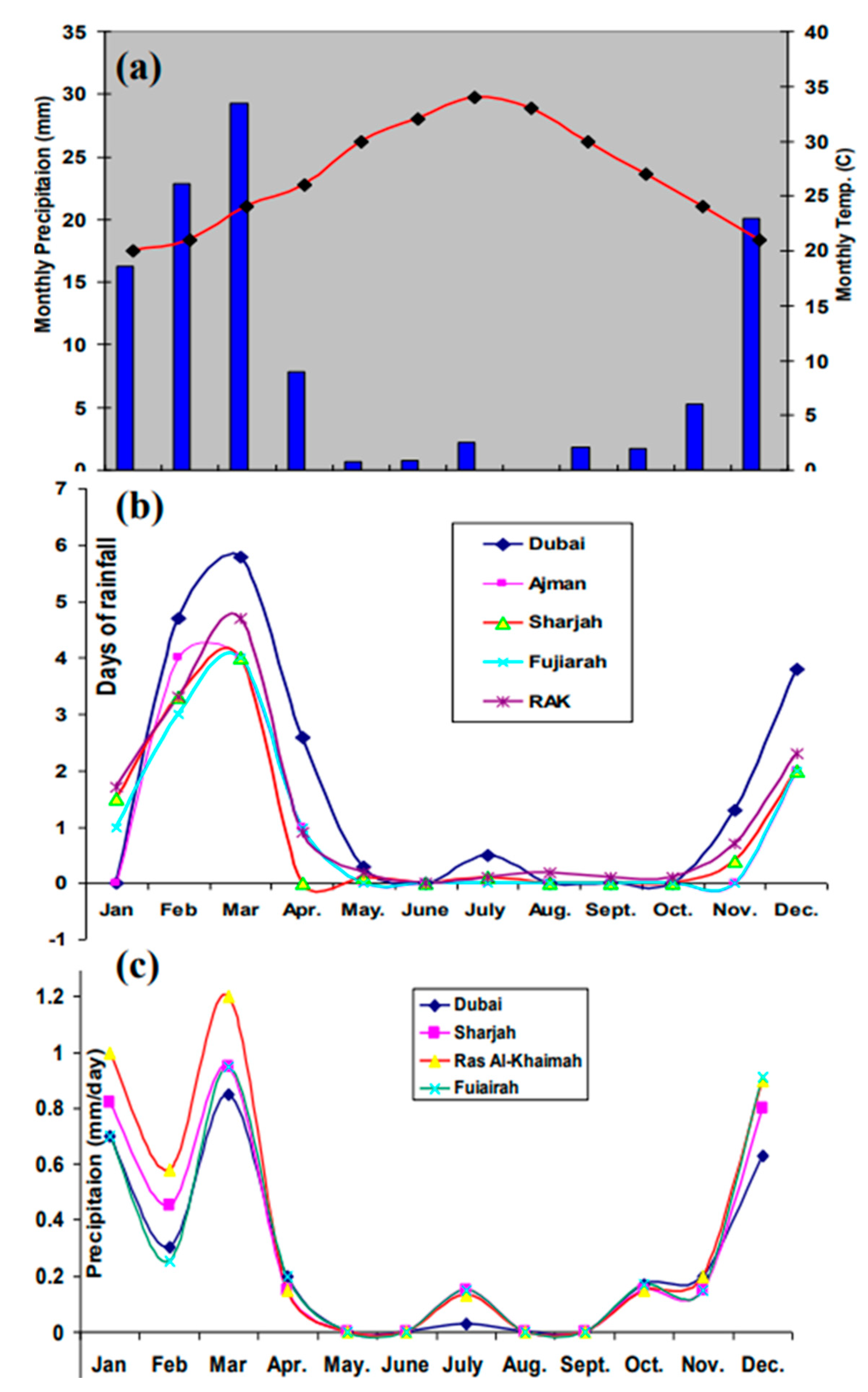
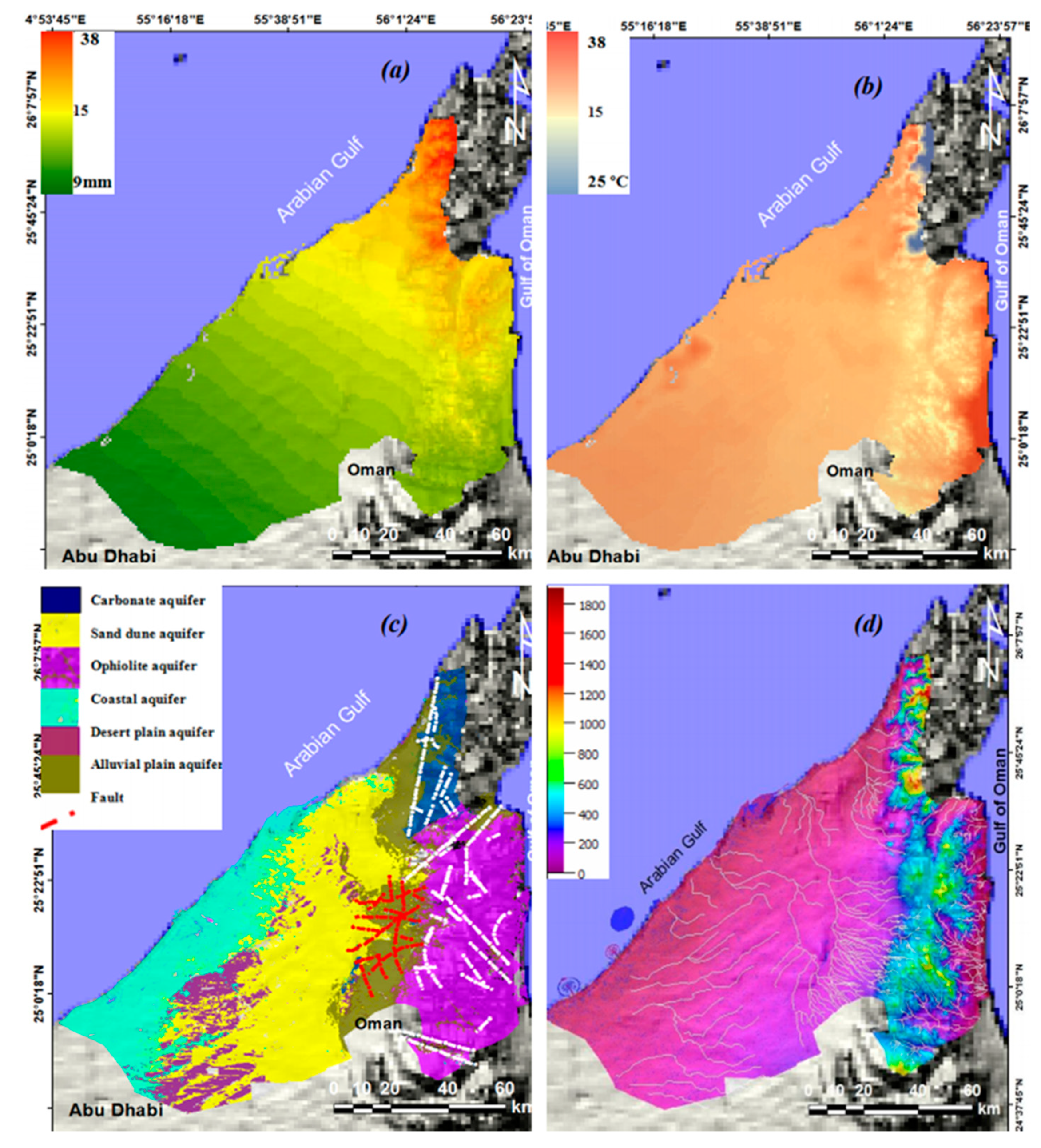
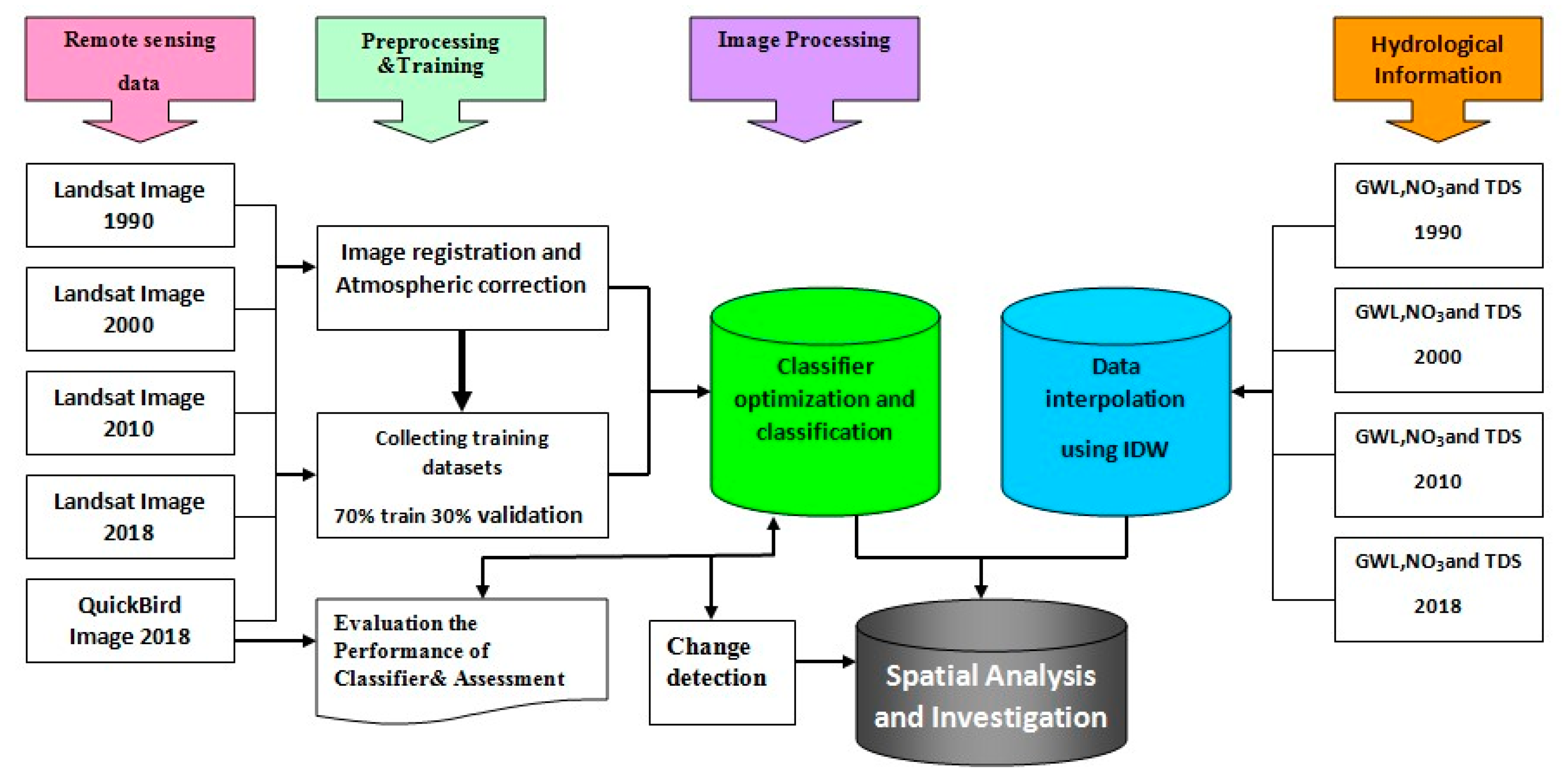


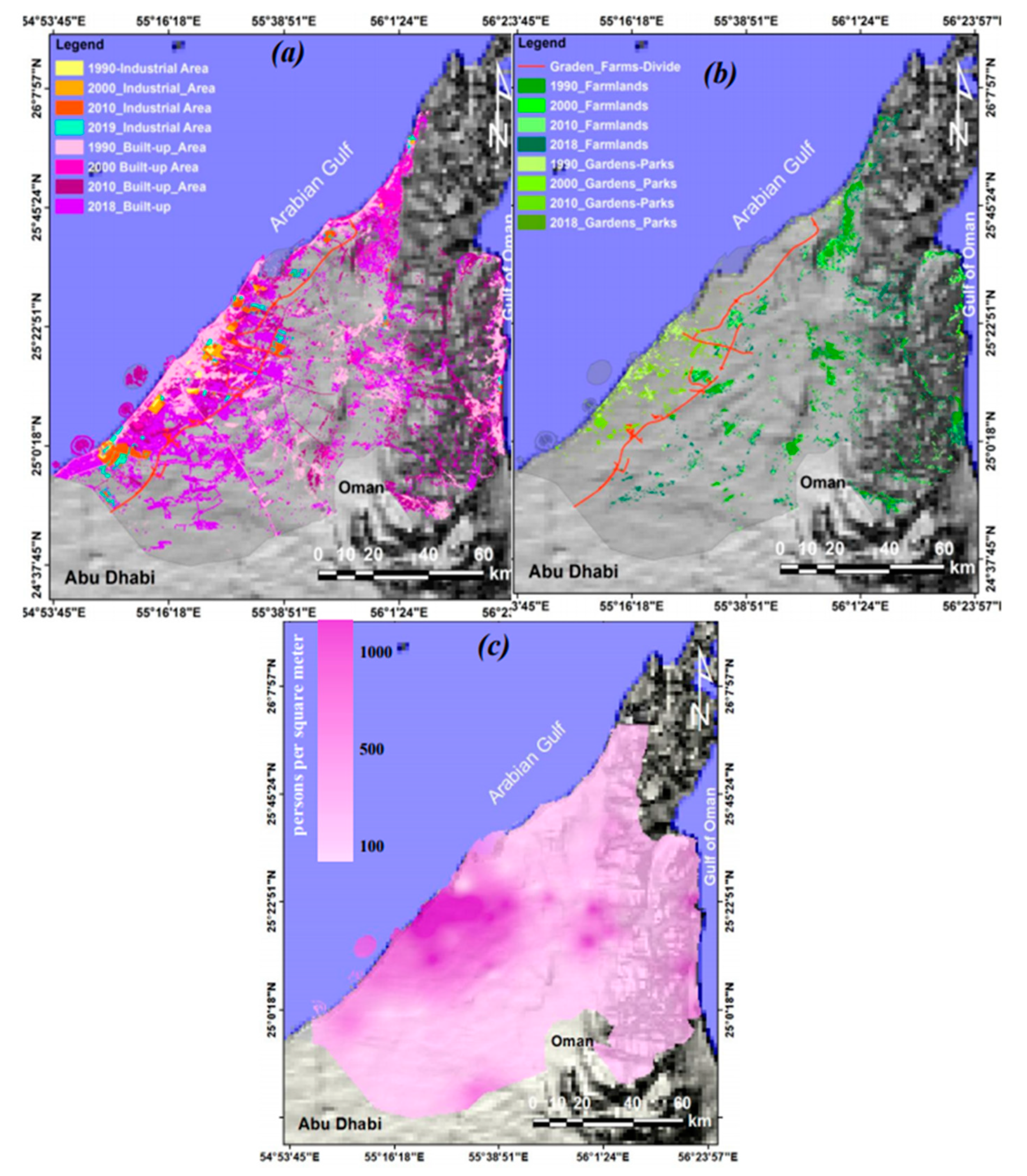









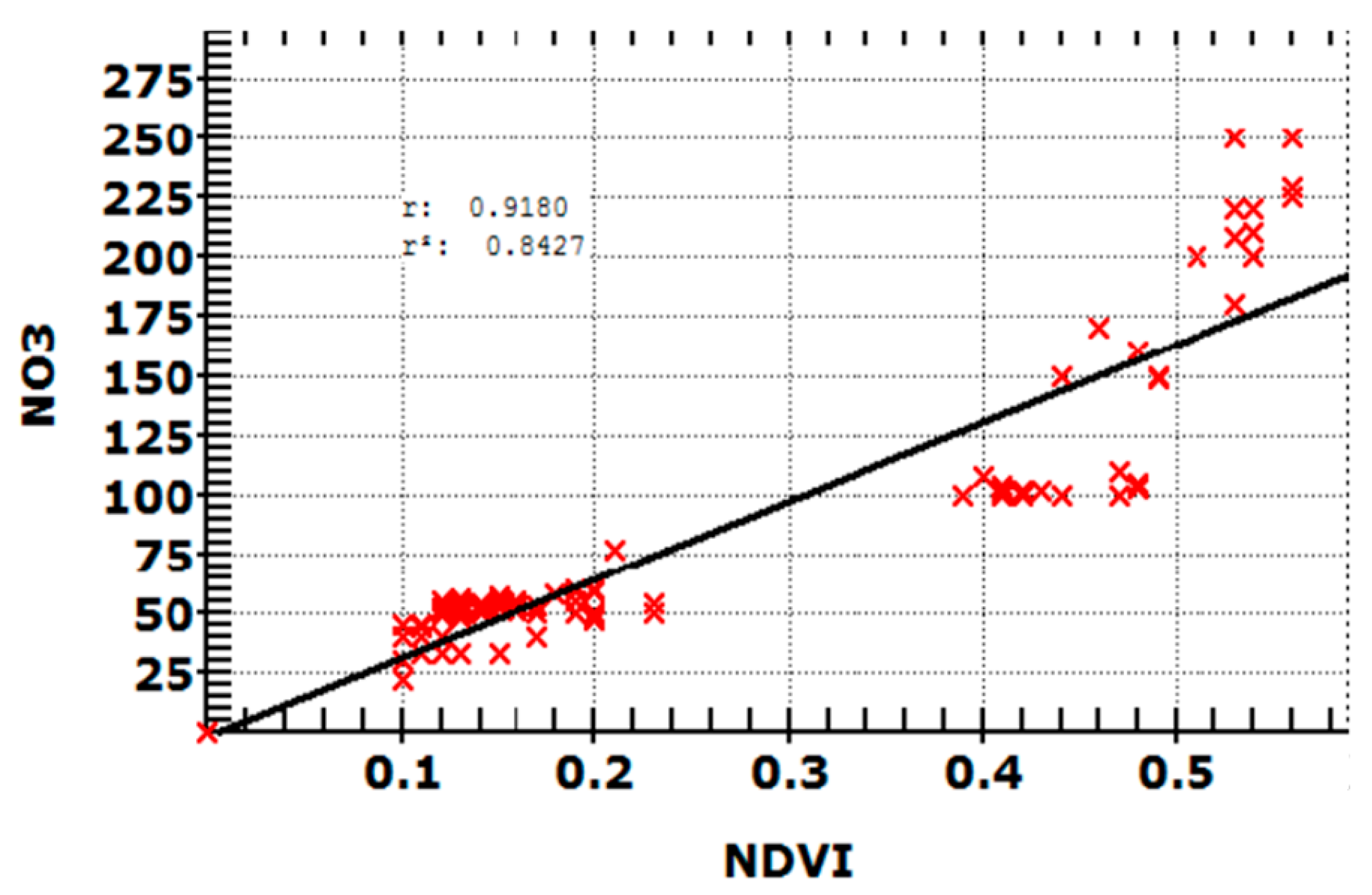

| Bands | Resolution (m) | Wavelength (mm) | |
|---|---|---|---|
| Thematic Mapper (TM)and Enhanced Thematic Mapper Plus (ETM+) (23 August 1990) (23 August 2000) | Band 1 | 30 | 0.45–0.52 |
| Band 2 | 30 | 0.52–0.60 | |
| Band 3 | 30 | 0.63–0.69 | |
| Band 4 | 30 | 0.77–0.90 | |
| Band 5 | 30 | 1.55–1.75 | |
| Band 6 | 60*(30) | 10.40–12.50 | |
| Band 7 | 30 | 2.09–2.35 | |
| Band 8 | 15 | 0.52–0.90 | |
| Landsat 8 Operational Land Imager (OLI)and thermal infrared sensor (TIRS) (15 August 2018) | Band 1 Coastal aerosol | 30 | 0.43–0.45 |
| Band 2 Blue | 30 | 0.45–0.51 | |
| Band 3 Red | 30 | 0.53–0.59 | |
| Band 4 Red | 30 | 0.64–0.67 | |
| Band 5 Near Infrared (NIR) | 30 | 0.85–0.88 | |
| Band 6 SWIR 1 | 30 | 1.57–1.65 | |
| Band 7 SWIR 2 | 30 | 2.11–2.29 | |
| Band 8 Panchromatic | 0.50–0.68 | ||
| Band 9 Cirrus | 30 | 1.36–1.38 | |
| Band 10 Thermal Infrared (TIRS) 1 | 100*(30) | 10.60–11.19 | |
| Band 11 Thermal Infrared (TIRS) 2 | 100*(30) | 11.50–12.51 | |
| QuickBird (27 August 2018) | B1 Blue | 450–520 | |
| B2 Green | 520–600 | ||
| B3 Red | 630–690 | ||
| Near IR | 760–900 | ||
| Pan | 450–900 |
| γ | P | Threshold | C |
|---|---|---|---|
| 0.1 | 0 | 0.02 | 100 |
| 0.03 | 1 | 0.03 | 100 |
| 0.005 | 2 | 0.05 | 120 |
| 0.007 | 2 | 0.04 | 110 |
| 1990 | 2000 | 2010 | 2018 | |
|---|---|---|---|---|
| Overall Accuracy (%) | 90.15 | 91.35 | 93.01 | 95.14 |
| Kappa Coefficient | 0.811 | 0.841 | 0.88 | 0.918 |
| Class | Subclass | 1990 | 2000 | 2010 | 2018 | ||||
|---|---|---|---|---|---|---|---|---|---|
| (km2) | (%) | (km2) | (%) | (km2) | (%) | (km2) | (%) | ||
| Build-up | Residential | 198.8 | 1.69 | 387.1 | 3.30 | 494.72 | 4.21 | 623.83 | 5.31 |
| Industrial | 28.46 | 0.24 | 52.70 | 0.44 | 168.92 | 1.44 | 245.94 | 2.09 | |
| Vegetation | Park/garden | 6.93 | 0.05 | 7.19 | 0.06 | 67.18 | 0.57 | 125.26 | 1.06 |
| Farmland | 64.76 | 0.55 | 64.79 | 0.55 | 149.71 | 1.27 | 128.84 | 1.09 | |
| Class | Subclass | 1990–2000 | 2000–2010 | 2010–2018 | 1990–2018 | ||||
|---|---|---|---|---|---|---|---|---|---|
| (km2) | (%) | (km2) | (%) | (km2) | (%) | (km2) | (%) | ||
| Build-up | Residential | 188.3 | 1.60 | 107.62 | 0.91 | 129.11 | 1.10 | 425.03 | 3.62 |
| Industrial | 24.24 | 0.20 | 116.22 | 0.99 | 77.02 | 0.65 | 217.48 | 1.85 | |
| Vegetation | Park/garden | 0.26 | 0.002 | 59.99 | 0.51 | 58.08 | 0.49 | 118.33 | 1.0 |
© 2020 by the authors. Licensee MDPI, Basel, Switzerland. This article is an open access article distributed under the terms and conditions of the Creative Commons Attribution (CC BY) license (http://creativecommons.org/licenses/by/4.0/).
Share and Cite
Elmahdy, S.; Mohamed, M.; Ali, T. Land Use/Land Cover Changes Impact on Groundwater Level and Quality in the Northern Part of the United Arab Emirates. Remote Sens. 2020, 12, 1715. https://doi.org/10.3390/rs12111715
Elmahdy S, Mohamed M, Ali T. Land Use/Land Cover Changes Impact on Groundwater Level and Quality in the Northern Part of the United Arab Emirates. Remote Sensing. 2020; 12(11):1715. https://doi.org/10.3390/rs12111715
Chicago/Turabian StyleElmahdy, Samy, Mohamed Mohamed, and Tarig Ali. 2020. "Land Use/Land Cover Changes Impact on Groundwater Level and Quality in the Northern Part of the United Arab Emirates" Remote Sensing 12, no. 11: 1715. https://doi.org/10.3390/rs12111715







